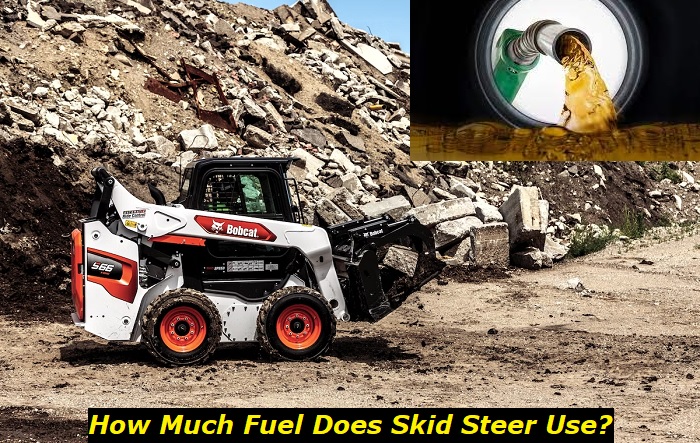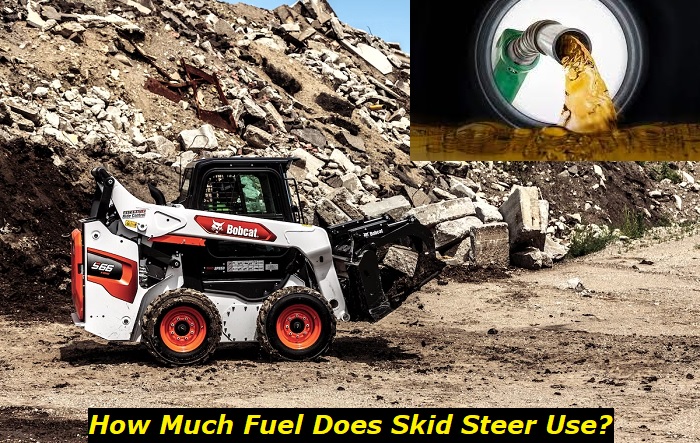Looking for information on the fuel efficiency of standard skid steers? Well, you’ve come to the right place! Whether you’re a curious kid or someone who wants to make an informed decision, this article will give you the lowdown on skid steer fuel efficiency. So let’s dive right in and discover how these versatile machines go easy on the gas!
If you’ve ever wondered How much fuel does a skid steer use? , you’re not alone. Many people want to know how efficiently these powerful machines operate. From construction sites to landscaping projects, skid steers are widely used across various industries. And understanding their fuel efficiency can help you plan better and save on costs. So, let’s take a closer look at how these workhorses perform when it comes to fuel consumption.
Buckle up, because we’re about to explore the different factors that affect the fuel efficiency of standard skid steers. From engine size and load capacity to operating conditions and maintenance, there’s a lot to consider. By the end of this article, you’ll have a solid understanding of how skid steers measure up in terms of fuel consumption and what you can do to optimize their efficiency. So, let’s get started and uncover the secrets behind the fuel efficiency of standard skid steers!

What’s the Fuel Efficiency of Standard Skid Steers?
Skid steers are versatile machines widely used in construction, agriculture, and landscaping industries. One important aspect to consider when choosing a skid steer is its fuel efficiency. Fuel efficiency not only impacts operating costs but also environmental sustainability. In this article, we will delve into the fuel efficiency of standard skid steers, exploring the factors that affect it and providing valuable insights for potential buyers.
Fuel Efficiency Factors for Standard Skid Steers
When evaluating the fuel efficiency of standard skid steers, several factors come into play. Understanding these factors will help you make an informed decision when selecting the right machine for your needs. Let’s take a closer look at some key aspects:
1. Engine Type and Power
The type of engine and its power significantly impact the fuel efficiency of a skid steer. Generally, skid steers feature either diesel or gasoline engines. Diesel engines tend to be more fuel-efficient than gasoline engines. The power of the engine is also a crucial factor. Higher engine power may result in increased fuel consumption. It is essential to strike a balance between engine power and fuel efficiency, depending on the kind of work the skid steer will be performing.
2. Operating Load and Speed
The operating load and speed at which a skid steer operates play a vital role in fuel consumption. The load capacity of the skid steer and the weight of the materials being carried or lifted affect the energy required to perform the task. Additionally, the speed at which the skid steer operates impacts fuel consumption. Higher speeds generally result in increased fuel consumption. Optimal load management and controlling the operating speed can help maximize fuel efficiency.
3. Attachment Usage
Attachments add versatility to skid steers, allowing them to perform a wide range of tasks. However, the type of attachment being used can affect fuel efficiency. Certain attachments, such as heavy-duty grapples or mulchers, may require more power and fuel to operate, impacting overall efficiency. It is crucial to consider the attachments you intend to use and their potential impact on fuel consumption.
4. Maintenance and Proper Operation
Maintenance practices and proper operation of the skid steer are essential for maintaining optimal fuel efficiency. Regular maintenance, including checking air filters, engine oil, and tire pressure, can help ensure the machine is operating at its best. Additionally, operating the skid steer within recommended guidelines, such as avoiding excessive idling and adopting smooth acceleration and deceleration, can contribute to improved fuel efficiency.
Tips for Maximizing Fuel Efficiency
1. Use the Appropriate Engine Power
Choosing the right engine power for your specific needs can help optimize fuel efficiency. Consider the type of tasks the skid steer will perform, the load capacity required, and the expected working conditions. Selecting an engine that meets these requirements without being excessively powerful can save fuel in the long run.
2. Match Attachment Usage to Task
Use attachments that are suitable for the task at hand. Using oversized attachments can result in increased fuel consumption due to the extra power required. Be mindful of the attachment’s weight and power requirements, using attachments that are specifically designed for the intended task.
3. Follow Routine Maintenance Schedule
Regularly maintain the skid steer as per the manufacturer’s recommendations. This includes tasks such as oil changes, filter replacements, and lubrication. Properly maintained machines operate more efficiently, resulting in better fuel economy.
4. Operate with Efficiency in Mind
Adopt fuel-efficient operating practices such as avoiding excessive idling, reducing unnecessary movements, and using smooth acceleration and deceleration. Properly managing the operating load and controlling speed can also contribute to improved fuel efficiency.
Benefits of Fuel-Efficient Skid Steers
Investing in fuel-efficient skid steers offers several advantages:
- Reduced Operating Costs: Fuel-efficient skid steers consume less fuel, resulting in lower operating costs. This can lead to significant savings over time.
- Environmental Sustainability: Skid steers with high fuel efficiency contribute to reducing carbon emissions and environmental impact.
- Extended Operating Time: Improved fuel efficiency means longer operating time per tankful, allowing for uninterrupted work and increased productivity.
- Improved Profitability: Lower fuel consumption and operating costs translate into improved profitability for businesses utilizing skid steers.
Conclusion
The fuel efficiency of standard skid steers is influenced by various factors such as engine type and power, operating load and speed, attachment usage, and maintenance practices. By considering these factors and adopting fuel-efficient operating practices, skid steer owners can maximize fuel efficiency, reduce operating costs, and contribute to environmental sustainability.
Remember, selecting the right skid steer for your specific needs, following proper maintenance routines, and operating efficiently can go a long way in ensuring optimal fuel efficiency and overall machine performance.
Key Takeaways: What’s the Fuel Efficiency of Standard Skid Steers?
Fuel efficiency is an important consideration when it comes to choosing a skid steer.
1. Skid steers have varying fuel efficiency levels based on factors like engine size and load capacity.
2. Smaller skid steers generally have better fuel efficiency than larger ones.
3. Operating a skid steer at lower engine speeds can help improve fuel efficiency.
4. Regular maintenance, such as cleaning air filters and checking tire pressure, can contribute to better fuel efficiency.
5. Choosing a skid steer with advanced fuel-saving technologies, like automatic engine idle shutdown, can further enhance fuel efficiency.
Frequently Asked Questions:
Looking to learn more about the fuel efficiency of standard skid steers? Here are some commonly asked questions and their answers:
1. How does the fuel efficiency of standard skid steers compare to other construction equipment?
Standard skid steers generally have better fuel efficiency compared to larger construction equipment like excavators or bulldozers. This is because skid steers are smaller and lighter, requiring less fuel to operate. Additionally, their compact design allows for better maneuverability, which can help optimize fuel consumption.
However, it’s important to note that fuel efficiency can vary depending on the specific model, engine size, and load capacity of the skid steer. It’s always a good idea to check the manufacturer’s specifications and compare fuel consumption rates before making a purchase decision.
2. How can I improve the fuel efficiency of my standard skid steer?
There are several ways you can improve the fuel efficiency of your standard skid steer. First, make sure you properly maintain the equipment by regularly checking and replacing air filters, fuel filters, and spark plugs. Clogged or dirty filters can reduce fuel efficiency.
Additionally, be mindful of your operating techniques. Avoid excessive idling and use the appropriate speed and throttle settings for the task at hand. Maintaining a consistent workload, rather than frequently changing buckets or attachments, can also help optimize fuel consumption. Lastly, regular servicing and tuning by a qualified technician can ensure your skid steer is running at its peak efficiency.
3. Are there any specific fuel-saving technologies available for standard skid steers?
Yes, some manufacturers offer fuel-saving technologies for standard skid steers. One example is the use of idle management systems that automatically reduce engine RPMs when the machine is not in use. This helps minimize fuel consumption during idle times, such as when waiting for materials or during breaks.
Another fuel-saving technology is the integration of electronic controls that optimize engine performance based on the machine’s workload. These controls can automatically adjust the engine’s fuel injection and timing to match the required power, resulting in better fuel efficiency.
4. Can I calculate the fuel efficiency of my standard skid steer?
Yes, you can calculate the fuel efficiency of your standard skid steer by keeping track of fuel consumption and the number of hours the machine has operated. Start by recording the initial fuel level and the hours meter reading. After a certain period of usage, fill up the fuel tank again and record the final fuel level and hours meter reading.
To calculate the fuel efficiency, subtract the initial fuel level from the final fuel level to determine the amount of fuel consumed. Then, divide the fuel consumed by the number of hours the machine operated to get the fuel consumption rate per hour. This calculation will give you an estimate of the fuel efficiency of your skid steer in terms of fuel consumed per hour of operation.
5. How can fuel efficiency impact the overall cost of owning a standard skid steer?
Fuel efficiency plays a significant role in the overall cost of owning a standard skid steer. A more fuel-efficient machine can help reduce fuel expenses, especially for long-term or intensive projects. Lower fuel consumption also means fewer refueling stops, saving valuable time and increasing productivity.
Moreover, fuel efficiency is closely tied to environmental sustainability. By choosing a fuel-efficient skid steer, you can contribute to reducing greenhouse gas emissions and minimizing your ecological footprint. This can potentially have a positive impact on your reputation as a responsible and environmentally conscious contractor.
7 Things I Wish I Knew Before Buying a Skid Loader + Basic Maintenance
Summary
Skid steers come in different sizes and have varying fuel efficiency rates.
Smaller skid steers tend to have better fuel efficiency than larger ones.
Fuel efficiency is affected by factors like engine power, weight, and load capacity.
Regular maintenance and proper operation can also improve fuel efficiency.
By considering these factors, you can choose a skid steer that meets your needs while saving on fuel costs.

